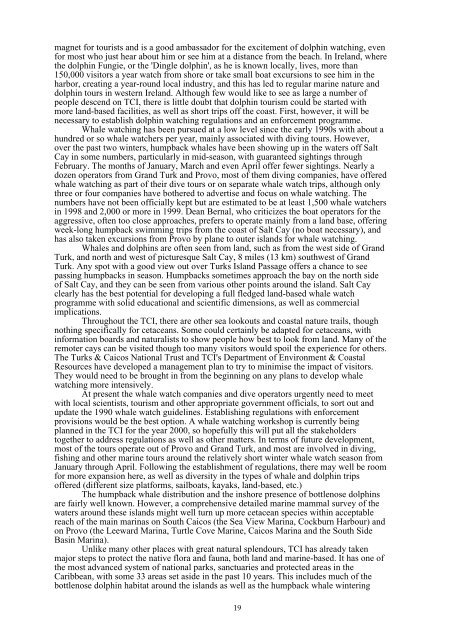The Potential of Whale Watching in the Caribbean: 1999+
The Potential of Whale Watching in the Caribbean: 1999+
The Potential of Whale Watching in the Caribbean: 1999+
Create successful ePaper yourself
Turn your PDF publications into a flip-book with our unique Google optimized e-Paper software.
magnet for tourists and is a good ambassador for <strong>the</strong> excitement <strong>of</strong> dolph<strong>in</strong> watch<strong>in</strong>g, even<br />
for most who just hear about him or see him at a distance from <strong>the</strong> beach. In Ireland, where<br />
<strong>the</strong> dolph<strong>in</strong> Fungie, or <strong>the</strong> 'D<strong>in</strong>gle dolph<strong>in</strong>', as he is known locally, lives, more than<br />
150,000 visitors a year watch from shore or take small boat excursions to see him <strong>in</strong> <strong>the</strong><br />
harbor, creat<strong>in</strong>g a year-round local <strong>in</strong>dustry, and this has led to regular mar<strong>in</strong>e nature and<br />
dolph<strong>in</strong> tours <strong>in</strong> western Ireland. Although few would like to see as large a number <strong>of</strong><br />
people descend on TCI, <strong>the</strong>re is little doubt that dolph<strong>in</strong> tourism could be started with<br />
more land-based facilities, as well as short trips <strong>of</strong>f <strong>the</strong> coast. First, however, it will be<br />
necessary to establish dolph<strong>in</strong> watch<strong>in</strong>g regulations and an enforcement programme.<br />
<strong>Whale</strong> watch<strong>in</strong>g has been pursued at a low level s<strong>in</strong>ce <strong>the</strong> early 1990s with about a<br />
hundred or so whale watchers per year, ma<strong>in</strong>ly associated with div<strong>in</strong>g tours. However,<br />
over <strong>the</strong> past two w<strong>in</strong>ters, humpback whales have been show<strong>in</strong>g up <strong>in</strong> <strong>the</strong> waters <strong>of</strong>f Salt<br />
Cay <strong>in</strong> some numbers, particularly <strong>in</strong> mid-season, with guaranteed sight<strong>in</strong>gs through<br />
February. <strong>The</strong> months <strong>of</strong> January, March and even April <strong>of</strong>fer fewer sight<strong>in</strong>gs. Nearly a<br />
dozen operators from Grand Turk and Provo, most <strong>of</strong> <strong>the</strong>m div<strong>in</strong>g companies, have <strong>of</strong>fered<br />
whale watch<strong>in</strong>g as part <strong>of</strong> <strong>the</strong>ir dive tours or on separate whale watch trips, although only<br />
three or four companies have bo<strong>the</strong>red to advertise and focus on whale watch<strong>in</strong>g. <strong>The</strong><br />
numbers have not been <strong>of</strong>ficially kept but are estimated to be at least 1,500 whale watchers<br />
<strong>in</strong> 1998 and 2,000 or more <strong>in</strong> 1999. Dean Bernal, who criticizes <strong>the</strong> boat operators for <strong>the</strong><br />
aggressive, <strong>of</strong>ten too close approaches, prefers to operate ma<strong>in</strong>ly from a land base, <strong>of</strong>fer<strong>in</strong>g<br />
week-long humpback swimm<strong>in</strong>g trips from <strong>the</strong> coast <strong>of</strong> Salt Cay (no boat necessary), and<br />
has also taken excursions from Provo by plane to outer islands for whale watch<strong>in</strong>g.<br />
<strong>Whale</strong>s and dolph<strong>in</strong>s are <strong>of</strong>ten seen from land, such as from <strong>the</strong> west side <strong>of</strong> Grand<br />
Turk, and north and west <strong>of</strong> picturesque Salt Cay, 8 miles (13 km) southwest <strong>of</strong> Grand<br />
Turk. Any spot with a good view out over Turks Island Passage <strong>of</strong>fers a chance to see<br />
pass<strong>in</strong>g humpbacks <strong>in</strong> season. Humpbacks sometimes approach <strong>the</strong> bay on <strong>the</strong> north side<br />
<strong>of</strong> Salt Cay, and <strong>the</strong>y can be seen from various o<strong>the</strong>r po<strong>in</strong>ts around <strong>the</strong> island. Salt Cay<br />
clearly has <strong>the</strong> best potential for develop<strong>in</strong>g a full fledged land-based whale watch<br />
programme with solid educational and scientific dimensions, as well as commercial<br />
implications.<br />
Throughout <strong>the</strong> TCI, <strong>the</strong>re are o<strong>the</strong>r sea lookouts and coastal nature trails, though<br />
noth<strong>in</strong>g specifically for cetaceans. Some could certa<strong>in</strong>ly be adapted for cetaceans, with<br />
<strong>in</strong>formation boards and naturalists to show people how best to look from land. Many <strong>of</strong> <strong>the</strong><br />
remoter cays can be visited though too many visitors would spoil <strong>the</strong> experience for o<strong>the</strong>rs.<br />
<strong>The</strong> Turks & Caicos National Trust and TCI's Department <strong>of</strong> Environment & Coastal<br />
Resources have developed a management plan to try to m<strong>in</strong>imise <strong>the</strong> impact <strong>of</strong> visitors.<br />
<strong>The</strong>y would need to be brought <strong>in</strong> from <strong>the</strong> beg<strong>in</strong>n<strong>in</strong>g on any plans to develop whale<br />
watch<strong>in</strong>g more <strong>in</strong>tensively.<br />
At present <strong>the</strong> whale watch companies and dive operators urgently need to meet<br />
with local scientists, tourism and o<strong>the</strong>r appropriate government <strong>of</strong>ficials, to sort out and<br />
update <strong>the</strong> 1990 whale watch guidel<strong>in</strong>es. Establish<strong>in</strong>g regulations with enforcement<br />
provisions would be <strong>the</strong> best option. A whale watch<strong>in</strong>g workshop is currently be<strong>in</strong>g<br />
planned <strong>in</strong> <strong>the</strong> TCI for <strong>the</strong> year 2000, so hopefully this will put all <strong>the</strong> stakeholders<br />
toge<strong>the</strong>r to address regulations as well as o<strong>the</strong>r matters. In terms <strong>of</strong> future development,<br />
most <strong>of</strong> <strong>the</strong> tours operate out <strong>of</strong> Provo and Grand Turk, and most are <strong>in</strong>volved <strong>in</strong> div<strong>in</strong>g,<br />
fish<strong>in</strong>g and o<strong>the</strong>r mar<strong>in</strong>e tours around <strong>the</strong> relatively short w<strong>in</strong>ter whale watch season from<br />
January through April. Follow<strong>in</strong>g <strong>the</strong> establishment <strong>of</strong> regulations, <strong>the</strong>re may well be room<br />
for more expansion here, as well as diversity <strong>in</strong> <strong>the</strong> types <strong>of</strong> whale and dolph<strong>in</strong> trips<br />
<strong>of</strong>fered (different size platforms, sailboats, kayaks, land-based, etc.)<br />
<strong>The</strong> humpback whale distribution and <strong>the</strong> <strong>in</strong>shore presence <strong>of</strong> bottlenose dolph<strong>in</strong>s<br />
are fairly well known. However, a comprehensive detailed mar<strong>in</strong>e mammal survey <strong>of</strong> <strong>the</strong><br />
waters around <strong>the</strong>se islands might well turn up more cetacean species with<strong>in</strong> acceptable<br />
reach <strong>of</strong> <strong>the</strong> ma<strong>in</strong> mar<strong>in</strong>as on South Caicos (<strong>the</strong> Sea View Mar<strong>in</strong>a, Cockburn Harbour) and<br />
on Provo (<strong>the</strong> Leeward Mar<strong>in</strong>a, Turtle Cove Mar<strong>in</strong>e, Caicos Mar<strong>in</strong>a and <strong>the</strong> South Side<br />
Bas<strong>in</strong> Mar<strong>in</strong>a).<br />
Unlike many o<strong>the</strong>r places with great natural splendours, TCI has already taken<br />
major steps to protect <strong>the</strong> native flora and fauna, both land and mar<strong>in</strong>e-based. It has one <strong>of</strong><br />
<strong>the</strong> most advanced system <strong>of</strong> national parks, sanctuaries and protected areas <strong>in</strong> <strong>the</strong><br />
<strong>Caribbean</strong>, with some 33 areas set aside <strong>in</strong> <strong>the</strong> past 10 years. This <strong>in</strong>cludes much <strong>of</strong> <strong>the</strong><br />
bottlenose dolph<strong>in</strong> habitat around <strong>the</strong> islands as well as <strong>the</strong> humpback whale w<strong>in</strong>ter<strong>in</strong>g<br />
19
















